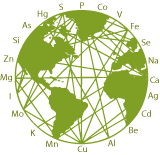CDC Facts
INFORMATION FROM THE CENTER FOR DISEASE CONTROL (CDC)
What is iodine?
Iodine is a naturally occurring element that is required for good health. Exposure to high levels of stable or radioactive iodine can cause damage to the thyroid. This chemical has been found in at least 9 of the 1,636 National Priorities List sites identified by the Environmental Protection Agency (EPA).
Iodine is a naturally occurring element found in sea water and in certain rocks and sediments. There are non radioactive and radioactive forms of iodine. Iodine is used as a disinfectant for cleaning surfaces and storage containers and is used in skin soaps and bandages, and for purifying water. Iodine is also added to some table salt to ensure that all people in the United States have enough iodine in their diet. Most radioactive iodine is manmade. It is used in medical tests and to treat certain diseases. Most radioactive forms of iodine change very quickly (seconds to days) to stable elements that are not radioactive.
Testing for Iodine
Aside from checking for radioactivity, tests involve examining blood, feces, saliva, urine, and hair to check for iodine.
Has the federal government made recommendations to protect human health?
The National Research Council has established a recommended dietary allowance (RDA) for iodine of 150 micrograms per day (150 µg/day), with additional allowances of 25 µg/day during pregnancy and 50 µg/day during nursing. These dietary intake levels are sufficient to satisfy the metabolic needs of the body.
Reference:
Agency for Toxic Substances and Disease Registry (ATSDR). 2004. Toxicological Profile for Iodine Atlanta, GA: U.S. Department of Health and Human Services, Public Health Service.
